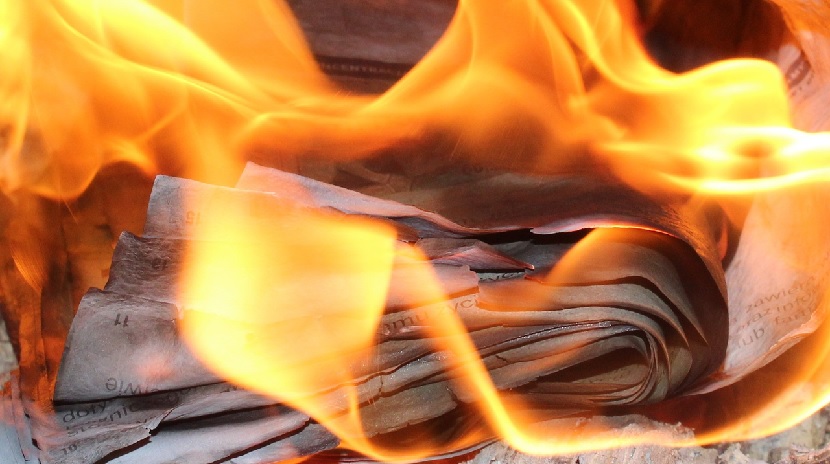“‘Stuff your eyes with wonder,’ he said, ‘live as if you’d drop dead in ten seconds. See the world. It’s more fantastic that any dream made or paid for in factories. Ask no guarantees, ask for no security, there never was such an animal.” — Ray Bradbury
Ray Bradbury was born a century ago, on August 22, 1920. If he were still alive, I’m afraid that those of us who work in the field of safety would be a disappointment. Everything we do is to make sure that no has to live as though they will drop dead in ten seconds.
His book, Fahrenheit 451, was about destroying knowledge, about book burning. It is a reminder of how important it is to preserve knowledge and to pass it along.
Fahrenheit 451 is also the first introduction most people ever had to the idea of “autoignition temperature,” and for many, the only. Perhaps then it should come as no surprise that many people, even safety professionals, don’t really understand autoignition temperatures (AITs).
Today, in celebration of the 100th anniversary of Ray Bradbury’s birth, I thought it would be fitting to preserve and pass along some knowledge about AITs.
What Is an Autoignition Temperature?
The AIT of a material is the temperature at which the material ignites in dry air at atmospheric pressure in the absence of any ignition source. Only combustible or flammable materials have an AIT. The measured AIT depends on the test method, the amount of time allowed for ignition to occur, and the form of the material. We stipulate that AIT is in dry air at atmospheric pressure because humidity makes ignition harder, raising the ignition temperature, and increased oxygen concentration makes ignition easier, lowering the ignition temperature.
Given a specific test method (typically ASTM E659), only pure materials have a specific AIT. Mixtures or composites will have autoignition temperature ranges which in turn depend on the range of compositions for that material. Pure ethanol (200 proof) has an AIT of 365 C (689°F), while gasoline or petrol, being a mixture a varying composition, has an AIT range of 247 – 280 C (477 – 536°F).
Trimethylborane – B(CH3)3 – has an extremely low AIT: -40 C (-40°F). Materials with an AIT at or below ambient temperatures are called “pyrophoric”.
Pyrophoricity
The UN’s Globally Harmonized System of Classification and Labelling of Chemicals (GHS) defines liquid and solids as pyrophoric as a liquid or solid “which, even in small quantities, is liable to ignite within five minutes after coming into contact with air.”
Pyrophoricity is a more complex phenomenon than simply having a low AIT, though. Many materials react with oxygen or moisture and generate heat. When those materials are very finely divided and very porous, their reaction with oxygen or water can heat them faster than the heat is dispersed, heating them to the point that they ignite. Metal powders, such as Raney nickel, powdered aluminum, and zinc dust are pyrophoric but without low autoignition. The same is true for alkali metals like sodium, potassium, and cesium.
However, there are materials with low AITs which are certainly pyrophoric. Triethylborane (AIT = -20 C (-4°F) ) and silane (AIT = 21 C (70°F) ) are both pyrophoric by virtue of their low AIT.
Autoignition Temperature vs. Flash Point
A term that is sometimes confused with AIT is flash point. As similar sounding as they are, AIT and flash point are not the same thing. AIT is the temperature at which any material spontaneously ignites. Flashpoint is the temperature at which a liquid releases enough vapor to form a flammable mixture, which then must be ignited.
Flammable mixtures in air, whether of gases or vapors, exist in a range from the lower explosive limit (LEL) to the upper explosive limit (UEL). Below the LEL, the mixture is too lean to burn. Above the UEL, the mixture is too rich to burn. The amount of vapor in air depends on the vapor pressure of the flammable liquid. As the temperature of the flammable liquid increases, the vapor pressure increases. A simple way to describe this relationship is the empirical Antoine equation, which takes the form
LogP = A – B/(C + T)
The flash point is the temperature at which the vapor pressure of the flammable liquid is exactly high enough to form a mixture at the LEL. The flash point for any material is much, much lower than the AIT. So, while the AIT for pure ethanol is 365 C (689°F), the flash point is 13 C (55°F). An ignition source can set ethanol alight well below room temperature, but it won’t spontaneously burst into flames until it is hotter than the capability of most kitchen ovens.
Is 451°F Really the Autoignition Temperature of Paper?
Paper is not a pure compound, so it doesn’t have a single AIT. The range of AIT of paper is generally reported as having a range of 218 – 246 C (424 – 475°F). Ray Bradbury’s AIT for paper, 451°F, certainly falls in the range.
There is a frequently-cited notion on the internet that Bradbury got it wrong, that the AIT for paper is actually 451 C. I bought it when I first encountered it because, I’ll admit, it’s fun to debunk widely accepted beliefs. Rather than attribute it to Bradbury confusing the two temperature scales, though, I thought that the “error” was simply due to a writer’s love of alliteration.
In fact, a 2012 post in Slate.com by Brian Palmer does a pretty good job of explaining how internet contrarians got it wrong, not Bradbury. Yet the mistake continues to appear in new posts. Sometimes its just too hard to let go of a startling bit of misinformation. I should have known that Bradbury had too much respect for the truth to play fast and loose with the facts. There is a lesson there for all of us.
